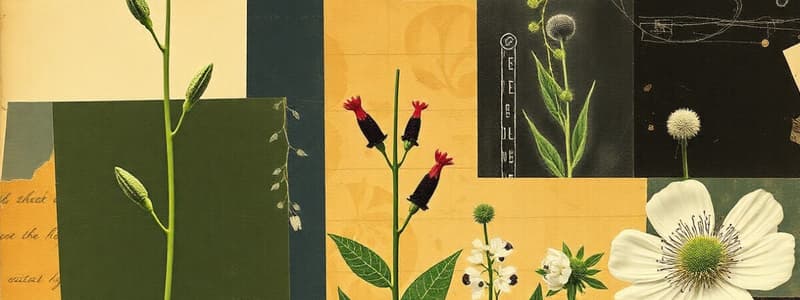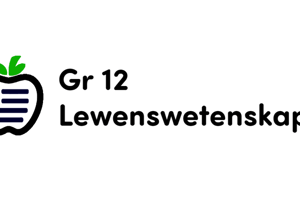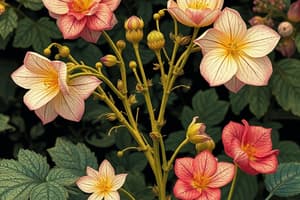Podcast
Questions and Answers
What role does Ethylene play in plant processes?
What role does Ethylene play in plant processes?
- Inhibits other hormones and helps in water loss
- Delays aging of leaves and promotes cell enlargement
- Stimulates flowering and increases stem growth
- Promotes fruit ripening and leaf abscission (correct)
Which hormone is primarily responsible for promoting cell division?
Which hormone is primarily responsible for promoting cell division?
- Auxins
- Cytokinins (correct)
- Gibberellins
- Abscisic Acid
What effect do Gibberellins (GA) have on plants?
What effect do Gibberellins (GA) have on plants?
- Stimulate flowering and break dormancy (correct)
- Increase root initiation and delay abscission
- Enhance water loss response and aging of leaves
- Promote cell enlargement and inhibit stem growth
Which hormonal action is primarily associated with Abscisic Acid (ABA)?
Which hormonal action is primarily associated with Abscisic Acid (ABA)?
What is one of the effects of Auxins on plant growth?
What is one of the effects of Auxins on plant growth?
Who proposed the concept of inheritance of acquired characteristics?
Who proposed the concept of inheritance of acquired characteristics?
What does epigenetics study?
What does epigenetics study?
What is considered the first revolution in evolutionary thought?
What is considered the first revolution in evolutionary thought?
Which of the following statements about fossils is true?
Which of the following statements about fossils is true?
What characterizes the third revolution in evolutionary thought?
What characterizes the third revolution in evolutionary thought?
What marks the beginning of the gametophyte generation?
What marks the beginning of the gametophyte generation?
Which process converts a sporophyte into a gametophyte?
Which process converts a sporophyte into a gametophyte?
How does the chromosome number in the gametophyte compare to that in the sporophyte?
How does the chromosome number in the gametophyte compare to that in the sporophyte?
Which of the following describes the end product of the gametophyte generation?
Which of the following describes the end product of the gametophyte generation?
What is the starting point of the sporophyte generation?
What is the starting point of the sporophyte generation?
What occurs during Prophase I of Meiosis?
What occurs during Prophase I of Meiosis?
What is the main outcome of Meiosis I?
What is the main outcome of Meiosis I?
Which phase of Meiosis involves the separation of chromatids?
Which phase of Meiosis involves the separation of chromatids?
During which phase do chromosomes align at the equator in Meiosis II?
During which phase do chromosomes align at the equator in Meiosis II?
What is the total result of one complete meiosis process in terms of cells produced?
What is the total result of one complete meiosis process in terms of cells produced?
What is the primary function of petals in flowering plants?
What is the primary function of petals in flowering plants?
Which part of the flower is responsible for protecting the flower bud?
Which part of the flower is responsible for protecting the flower bud?
What do stamens primarily produce in flowering plants?
What do stamens primarily produce in flowering plants?
Which components are contained within the carpels of a flower?
Which components are contained within the carpels of a flower?
Which of the following is NOT a function of sepals?
Which of the following is NOT a function of sepals?
Which function is associated with petals in a flower?
Which function is associated with petals in a flower?
Stamens are primarily responsible for which of the following?
Stamens are primarily responsible for which of the following?
Which of the following components is NOT included in the carpels of a flower?
Which of the following components is NOT included in the carpels of a flower?
What structures are contained within carpels?
What structures are contained within carpels?
Flashcards
Auxin function
Auxin function
Promotes cell growth, stem growth, root development, and delays leaf drop.
Gibberellin's job
Gibberellin's job
Stimulates stem growth, flowering, and breaks dormancy.
Cytokinin effect
Cytokinin effect
Encourages cell division and prevents leaves from aging.
ABA's role
ABA's role
Signup and view all the flashcards
Ethylene function
Ethylene function
Signup and view all the flashcards
Aristotle's Classification
Aristotle's Classification
Signup and view all the flashcards
Leonardo da Vinci's Fossil Discovery
Leonardo da Vinci's Fossil Discovery
Signup and view all the flashcards
Lamarck's Inheritance of Acquired Traits
Lamarck's Inheritance of Acquired Traits
Signup and view all the flashcards
What is Epigenetics?
What is Epigenetics?
Signup and view all the flashcards
The First Evolutionary Revolution
The First Evolutionary Revolution
Signup and view all the flashcards
Gametophyte Generation
Gametophyte Generation
Signup and view all the flashcards
Sporophyte Generation
Sporophyte Generation
Signup and view all the flashcards
Meiosis
Meiosis
Signup and view all the flashcards
Fertilization
Fertilization
Signup and view all the flashcards
Alternation of Generations
Alternation of Generations
Signup and view all the flashcards
Crossing-over
Crossing-over
Signup and view all the flashcards
How does Meiosis II differ from Meiosis I?
How does Meiosis II differ from Meiosis I?
Signup and view all the flashcards
What is the end result of Meiosis?
What is the end result of Meiosis?
Signup and view all the flashcards
Why is Meiosis important?
Why is Meiosis important?
Signup and view all the flashcards
Sepal's Role
Sepal's Role
Signup and view all the flashcards
Petal's Purpose
Petal's Purpose
Signup and view all the flashcards
Stamen Structure
Stamen Structure
Signup and view all the flashcards
What's inside the Carpel?
What's inside the Carpel?
Signup and view all the flashcards
Pollen's Journey
Pollen's Journey
Signup and view all the flashcards
What does the Stamen produce?
What does the Stamen produce?
Signup and view all the flashcards
What is the role of the Stigma?
What is the role of the Stigma?
Signup and view all the flashcards
Study Notes
Plant Hormones
-
Auxins: Promote cell growth, stem elongation, root development, and prevent leaf drop.
-
Gibberellins (GA): Increase stem growth, trigger flowering, and break dormancy.
-
Cytokinins: Stimulate cell division and slow down leaf aging.
-
Abscisic Acid (ABA): Inhibits other hormones and assists the plant's response to water loss.
-
Ethylene: Accelerates fruit ripening and leaf detachment.
Studying That Suits You
Use AI to generate personalized quizzes and flashcards to suit your learning preferences.




